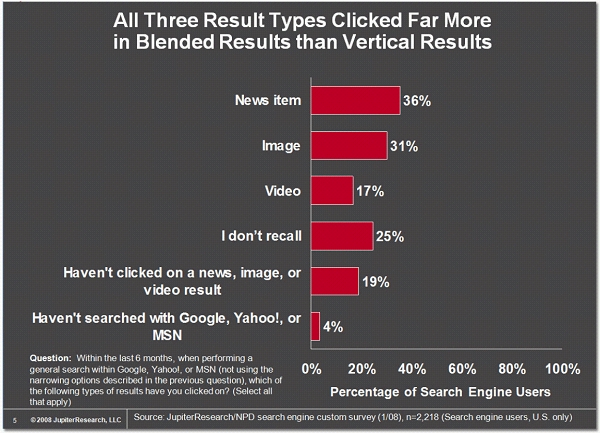If you’re not yet optimizing your news, image, and video content, you need to start. Another study released this week backs up previous research indicating that blended, or universal search is changing the way users search. Making sure your specialized content is showing up in search results is now even more important than it was before.
At Search Engine Strategies New York last month, comScore revealed exclusive universal search data that showed many more searchers than expected are seeing blended search results.
That data, gathered during one week in January, showed that there were 220 million universal search results, of the total 1.2 billion search queries in the U.S. That means 17 percent of all searches on Google showed at least one result with video, news, images, maps, weather, or stocks.
In fact, of the 87 million people who searched during that same week in January, 57 percent of them saw some type of universal search result. Of those, 38 percent saw a video result, 34 percent saw news, 19 percent saw images, and 15 percent saw multiple types of results.
So you’re still not convinced that optimizing for universal search is worth your time? This week, search marketing firm iProspect came out with more research emphasizing the prevalence of blended search results, and the way they change the behavior of searchers.
In the iProspect Blended Search Results Study, conducted by Jupiter Research for iProspect, the data showed that searchers are much more likely to click on image, news, or video search results when they are presented in a blended format.
“A single Web page no longer reigns supreme,” said Robert Murray, president of iProspect. “Marketers need to pay attention to the changes in search engine algorithms, and understand how blended results are affecting their category.”
In fact, a full 35 percent of respondents said they do not use vertical search, and 25 percent do not recall if they have clicked a result after having used vertical search (60 percent combined). But when those results are presented in blended, or universal search results, 36 percent of searchers click on “news” results, more than twice as much as the 17 percent of respondents who do so when they use the vertical “news search.”
For “image” search results 31 percent report clicking on those results within blended search, while 26 percent do so when utilizing vertical “image search.” And 17 percent of respondents report clicking “video” results within blended search results, compared to 10 percent who do so in a vertical “video search” result.
Overall, only 19 percent of search engine users report that they have not clicked a news, image, or video search result within the blended search results.

While this information seems obvious to many search marketers, Murray insists that most companies are still not aware of the issues around blended search results. And even when they are made aware, they often find themselves facing a situation where they need to go back and acquire digital rights to the images and video they have been using in their offline marketing materials. For that reason, many of iProspect’s clients are opting to create new content to use online, rather than reusing offline content.
